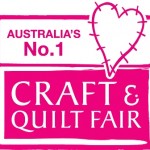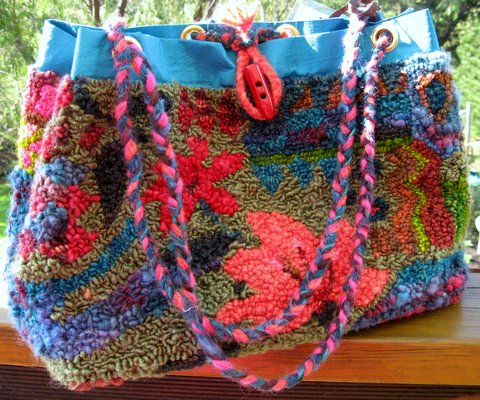ISSN 2207-100X June 2020
As the COVID-19 restrictions ease, many groups have started gathering images and information to record what their members were doing during isolation. Stuck on their own, most people began to reach out online to connect and share with friends, it took them in some surprising directions.
Seeing the image of a red-tailed black cockatoo posted on  Facebook by Sue who works in an indigenous community in Finke in the Northern Territory and who is eager to learn rughooking, prompted me at home in Western Australia, to draw up a rug hooking pattern for Sue based on the image and including flowers and leaves from a tree in my front garden.
Facebook by Sue who works in an indigenous community in Finke in the Northern Territory and who is eager to learn rughooking, prompted me at home in Western Australia, to draw up a rug hooking pattern for Sue based on the image and including flowers and leaves from a tree in my front garden.
A series of photographs to document the process was sent to Kira in Albany who had offered to “stitch” them together into a video. Kira’s search online for a cockatoo call to create a soundtrack for the video, led her to discover the image shared was showing on the website of the Museum of WA – photographer; Keith Lightbody.
Aware of copyright rules, I contacted the Museum for their permission, and also contact details for the photographer. Permission to use the image was given by both. Keith works with educators sharing his extensive knowledge of photography of birds and macro wildflowers – seen here on his website.
As an educator Keith Lightbody was interested to hear the black cockatoo design was to be used as a collaborative teaching project and spoke of a textile piece of importance to him through a family connection.
 “One of my treasured possessions is my Grandmother’s hand sewn quilt. I lived with my Grandma at Maddington for a number of years and she explained that in 1933 the Western Mail had printed a new wildflower design every week. This was part of an Australia wide activity to sew a quilt that included 24 wildflower images in nine inch (23cm) squares, and 1 pattern repeated 25 times. When she had completed by hand sewing all the pieces they were then assembled into a quilt with a plain border. Grandma (Phyllis Blanche Gardiner) was born in 1891 and living with her gave me a unique perspective on life. She was incredibly dedicated to family and an avid gardener – I learned many things from her!”
“One of my treasured possessions is my Grandmother’s hand sewn quilt. I lived with my Grandma at Maddington for a number of years and she explained that in 1933 the Western Mail had printed a new wildflower design every week. This was part of an Australia wide activity to sew a quilt that included 24 wildflower images in nine inch (23cm) squares, and 1 pattern repeated 25 times. When she had completed by hand sewing all the pieces they were then assembled into a quilt with a plain border. Grandma (Phyllis Blanche Gardiner) was born in 1891 and living with her gave me a unique perspective on life. She was incredibly dedicated to family and an avid gardener – I learned many things from her!”
Keith provided this additional information about the Wildflower quilt taken from Bridget Jolly Chronicle-Quilts Part 2.2
“The interest in Australian flora and fauna engendered from the 1889s by Federation, the 1903s added much national natural scientific study and discovery. In Sydney the artist Eirene Mort (1879-1977) who returned to Australia in 1906 from six years study in London from 1899, ‘designed extensively for embroidery’.37 For three of those years in London she studied at the Royal School of Needlework, South Kensington. Through the Royal School of Needlework’s employment service she gained a number of design jobs, the most important of which resulted in designs for textiles featuring Australian floral motifs. 37 C Menz, Australian Decorative Arts 1829s-1990s: Art Gallery of South Australia. P.64.”
Funny how one thing leads to another …………. over a 100 years later The Royal  School of Needlework in London (mentioned above) came up in an online conversation I had with Sally, a rug hooker from Queensland, we’d met at Judi Tompkins studio on the Sunshine Coast in Queensland.
School of Needlework in London (mentioned above) came up in an online conversation I had with Sally, a rug hooker from Queensland, we’d met at Judi Tompkins studio on the Sunshine Coast in Queensland.
 Sally is now in London doing a 3-year course at the Royal School of Needlework and has been sharing a Blog of her experiences – her travels prior to starting at RSN and images of her progress – which she has given permission to be shown here. Her last post said ….
Sally is now in London doing a 3-year course at the Royal School of Needlework and has been sharing a Blog of her experiences – her travels prior to starting at RSN and images of her progress – which she has given permission to be shown here. Her last post said ….
“During these last few months I have been progressing through the third and final term of my First Year on the Future Tutors Course, and what a strange and interesting learning experience this term it has been!
All Tuition across the entire term has been delivered either digitally/online. The way the RSN tutors have adapted their delivery and supported our learning has been brilliant.
Alongside the usual Art and Design classes this term, the principle embroidery techniques that I am studying are Botanical Silkshading and Mixed Whitework .
Botanical Silkshading
For the Silkshading subject I choose a Waterlily blossom as my source image, and a rich blue Silk Dupion as my ground fabric. We also needed to include some stem and a leaf with a turnover in the final design, however as Waterlily leaves can be really big I ended up including only a partial leaf rather than the whole thing in my composition. Stitching this Waterlily has proven to be challenging as the particular flower I am stitching has some turnover element within most petals, as well as the very obvious larger turnover on the partial leaf.
I have not yet completed this piece though it is well underway, and once finished this piece will still need to be hard mounted in the traditional RSN style.
Whitework
The Mixed Whitework classes have covered a wide range of whitework techniques such as Shadow Work, Broderie Anglaise, Richelieu, Pulled patterns and Drawn Thread embroidery. There are actually 3 distinct pieces of combined embroidered works to be handed in for this subject and each of these is worked on the different type of ground fabric. Alternating across each of these techniques has proven to be challenging as sometimes you just need to push ahead with embroidering on the one piece – once you have got the tension just right.
As I was developing the design for the mixed ‘Pulled and Drawn Thread’ piece I kept thinking about where I was being pulled and drawn to during the lockdown, and as a result I decided to try to design this piece to look like an antique map of Australia. While the piece is still in progress I am happy how it is coming along so far, though I still have a lot of additional Drawn Thread work to do.
Like so many others I find myself suffering a little from Lockdown Lassitude so everything I am sampling or embroidering seems to be taking longer to complete than I had expected.
So for now the stitching journey continues and thankfully the lockdown is easing a little, and the days are getting longer and warmer as Summer is on the way.”
Due to the COVID-19 restrictions, with classes being held online and no travel allowed, Sally had more time to search the web for needlework designs. This book on embroidery, crochet and yes, even rug hooking, caught her attention “The Home Art Book of Fancy Stitchery” by Flora Klickmann (1867-1958) Published in 1912 by Girls Own Paper & Womans Magazine. [Read More]
Some of the early crochet patterns from original books, now in the public  domain, can be downloaded from the Antique Pattern Library. Click the link and scroll down to page 52 for the section about rug making, particularly Knitted Piece Rugs made from Clippings – according to the author, these are best known in England using pieces of wool fabric about 3 inc long 1 inc wide, usually stitched (hooked) into canvas (what we know as proggy or proddy rugs) however she “found a knitted piece rug easier to do and wears better” – these are small woollen pieces knitted into strips using knitting cotton then stitched together.
domain, can be downloaded from the Antique Pattern Library. Click the link and scroll down to page 52 for the section about rug making, particularly Knitted Piece Rugs made from Clippings – according to the author, these are best known in England using pieces of wool fabric about 3 inc long 1 inc wide, usually stitched (hooked) into canvas (what we know as proggy or proddy rugs) however she “found a knitted piece rug easier to do and wears better” – these are small woollen pieces knitted into strips using knitting cotton then stitched together.
The author talks about homely rugs in New England and many out-of-the-way villages in other States of the USA and references the circular braided rugs –
“These are made in a variety of ways, though the main principle is the same; old stuff is knitted or crocheted into something approaching a rope, and this is then coiled round and round (starting from the centre) till a round or oval mat is formed of the desired size.“
Other types of braided rugs mentioned were, plaited/braided – from lengths of heavy woollens or rugs made simply from strips of rags, knit up into a rug on two very thick wooden needles.
Below is a contemporary version, knitted by Miriam Miller (NSW) using not rags but strips of T-shirts in my favourite colours.
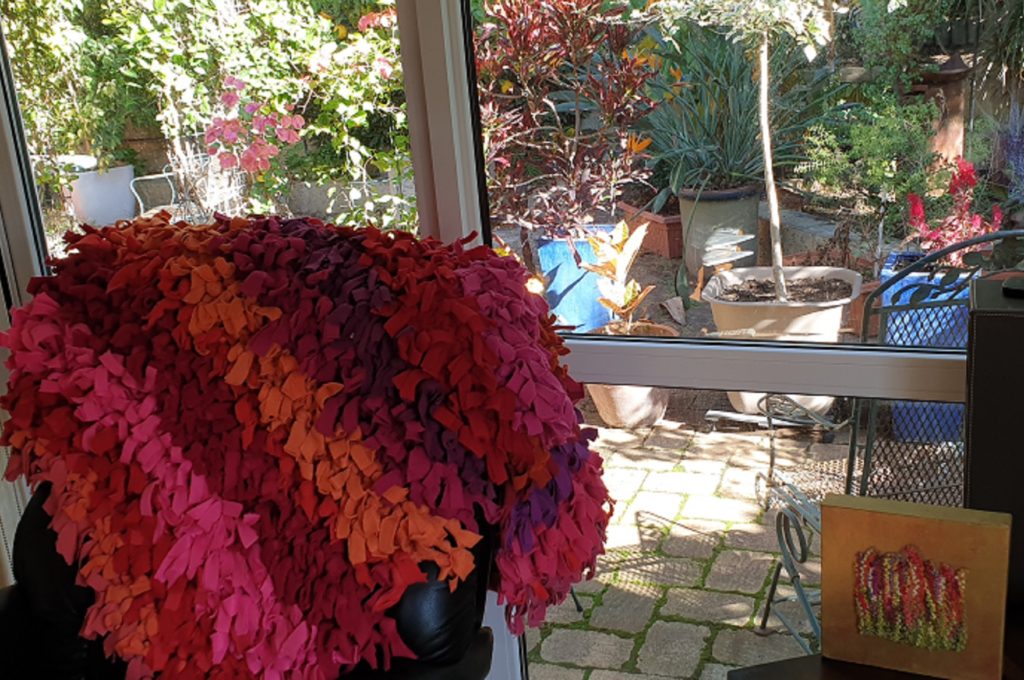
From the easy access of online research, we learn much about the beginnings of the old crafts.
The question is, how can we interest the younger generation to want to learn to carry them on. Children take quickly to the simple rug making techniques – young adults on the other hand are keen to travel, have busy lives with work and families of their own and with limited time – these slow techniques that seem to require large stashes of fabric, just don’t fit in to their busy lifestyle. It’s not until retirement approaches, does learning a craft come to mind, and pulling loops is not high on the list.
We need to do something creative and innovative to change this.
Most of what you find online about rugmaking originates in the Northern Hemisphere. We in Oz should not see this question from the standpoint of the North … we are different because we don’t have the history and the investment (financially and historically) in this craft …. it’s a business in the North (supplies and designs) that many instructors have taken online, unable during COVID-19 to travel to teach at workshops and attend fairs – but not here. We’re more likely to come up with our own designs, fashion tools locally and to “join forces” with another craft or craft group … so there is more interest in Mixed-media which seems to appeal to younger folks. “Rules” and strict adherence to how it has “always been done in the old days” is off putting for many. Designs and techniques need to be more flexible, we need to allow and encourage more innovation, working on smaller projects seems to be the way to go for beginners.
It’s important to recognise and validate that both crafts (in general) and rugmaking (in particular) fall along a continuum …. one isn’t “better” than another …. gaining confidence and interest in ANY craft/rug work should lead to a curiosity about the other techniques. Certain “schools” of rugmaking will not survive or grow in this country since they are so restrictive in the techniques, patterns and materials …. the artistic and precise work we see online from the North is great, wonderful pieces that appear to replicate tapestries, however this maybe daunting for a beginner.
Recognising that in this climate (even in southern Australia) we don’t need lots and lots of rugs …. and for those older members … rugs are a hazard on the floor, maybe we should be looking at combining rug hooking with other textile techniques and starting beginners off to create smaller home-wares projects, possibly even wearable art. This fits right in with the current emphasis on re-use, recycle, buy less and value hand-made. The current philosophy of sustainability takes us back to how the craft of rugmaking began. The difference is we’re now seen as doing something worthwhile for the planet and the old stigma of reusing, something done out of necessity by the poor, has gone. Besides the recycled materials are brighter in colour which gives the pieces a more contemporary look.
The world of technology allows us learn of these old crafts and network, to be inspired to continue to create and appreciate the value of handmade items. However, while technology played a big part in the lock-down – families came together and there was a resurgence of board games and jigsaw puzzles along with an interest in actually learning a craft.
 The question is, as the restrictions are eased, will this interest in a slower creative lifestyle continue, or will life go back to the frenetic pace it was? You’re welcome to leave your thoughts and comments below or email and send images of your work and messages to rughookingaustralia@gmail.com
The question is, as the restrictions are eased, will this interest in a slower creative lifestyle continue, or will life go back to the frenetic pace it was? You’re welcome to leave your thoughts and comments below or email and send images of your work and messages to rughookingaustralia@gmail.com
Editor; Australian Rugmakers Guild










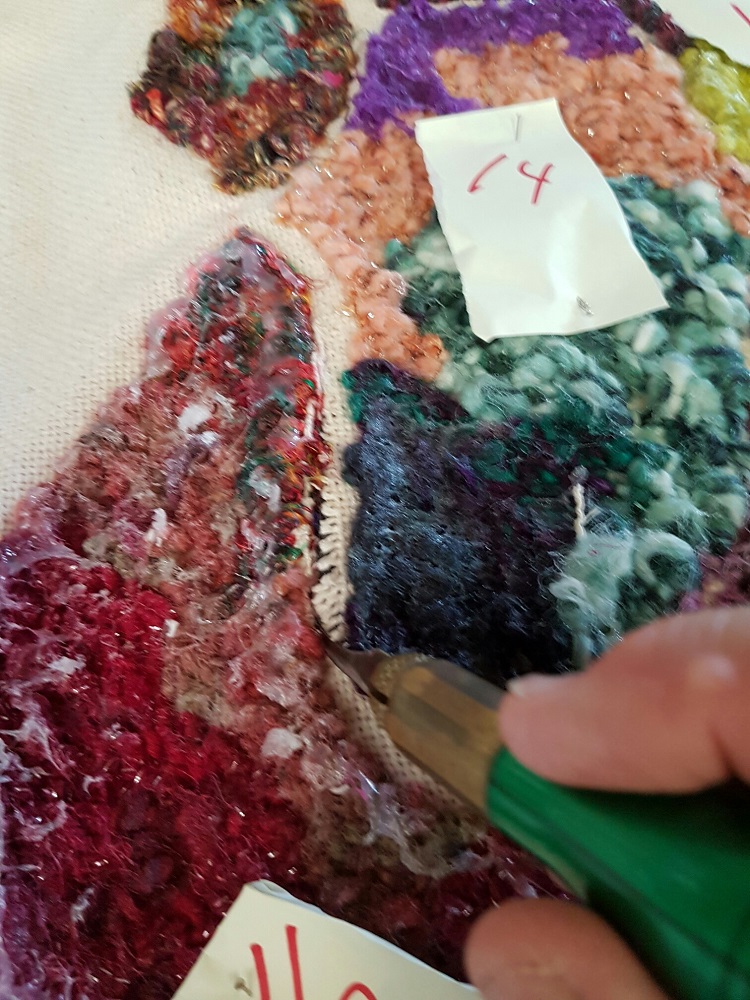

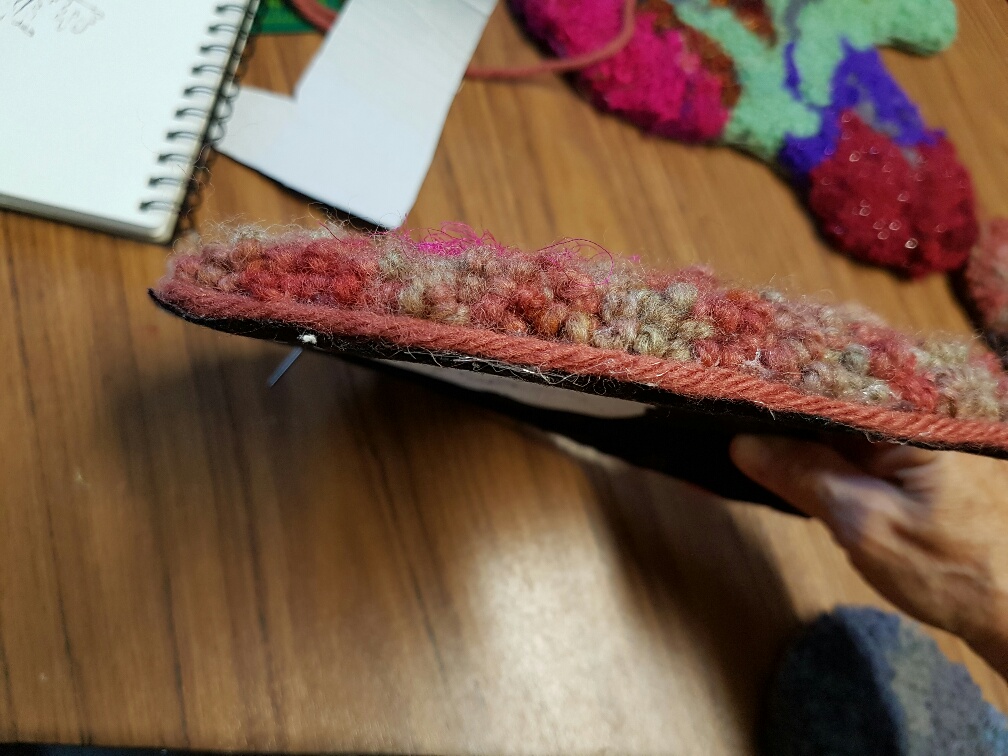
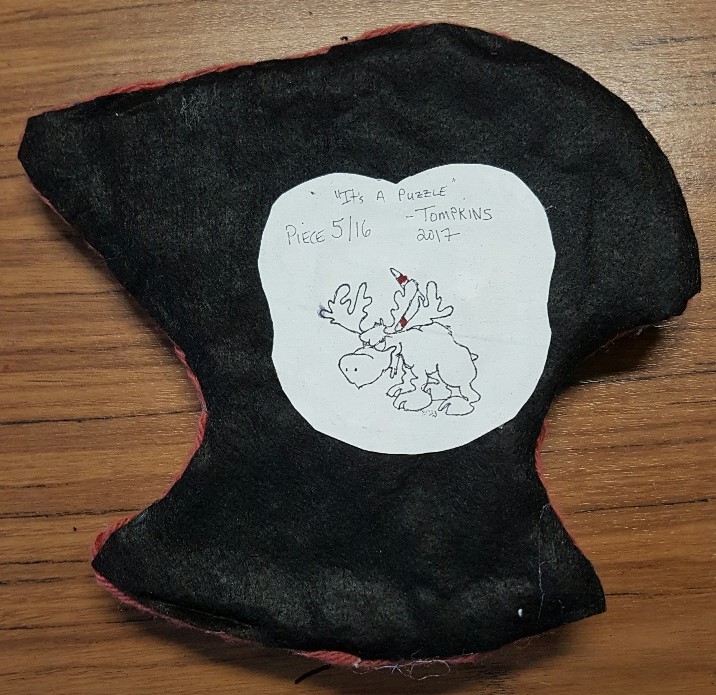


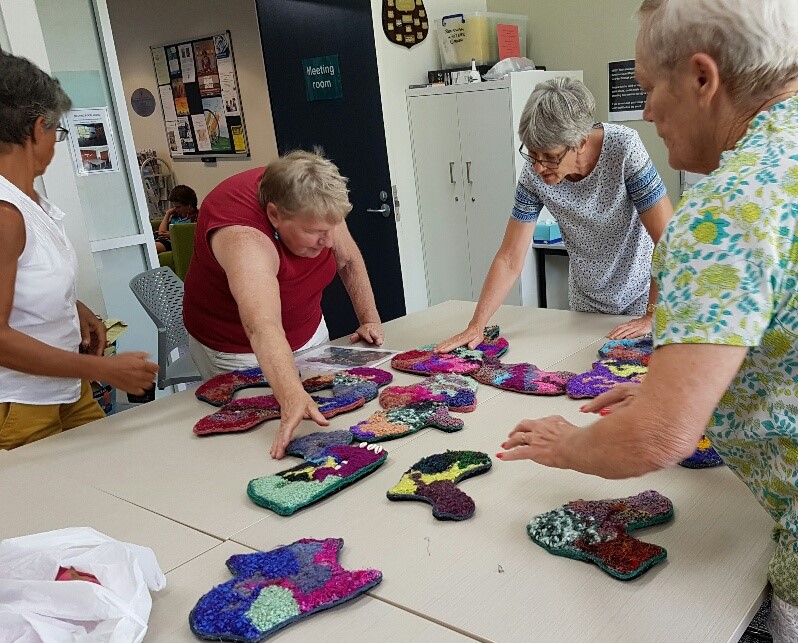

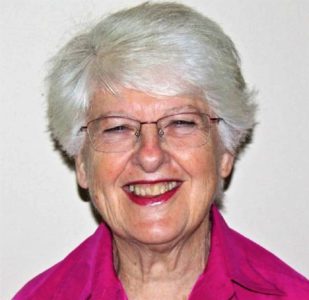

 s community project.
s community project.



 Maggie Whyte, Curator,
Maggie Whyte, Curator, 




 the post about a search for grey army blankets to finish off a large rug generated much interest.
the post about a search for grey army blankets to finish off a large rug generated much interest. 


